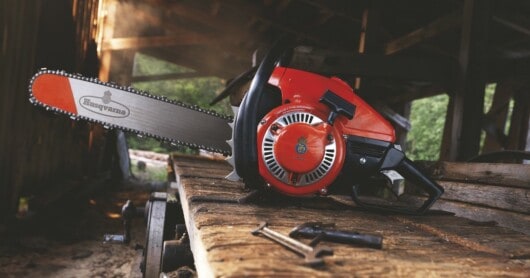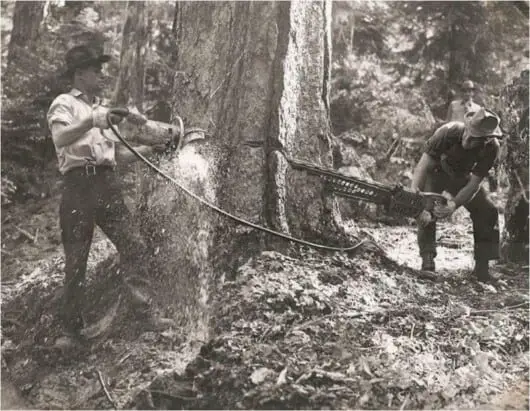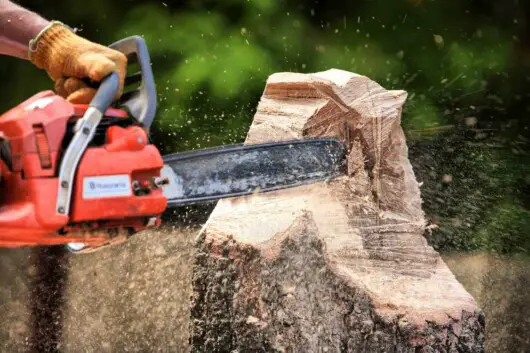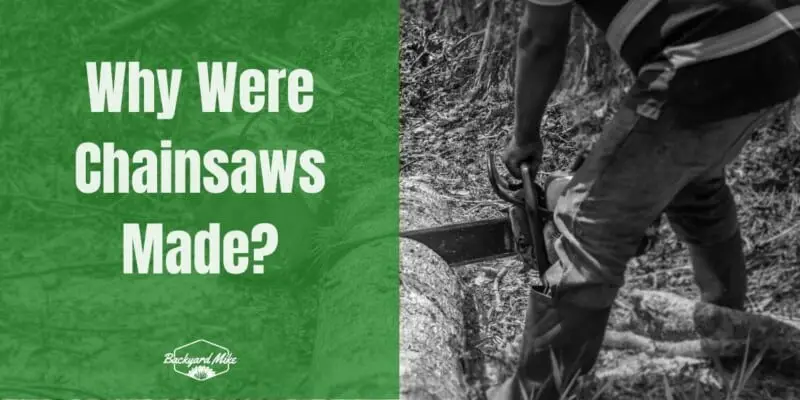Chainsaws are one of the most useful and versatile tools in modern-day life, but have you ever wondered why and when they were made? In this article, we’ll take a look through the history and purpose of chainsaws. From their initial invention to the many uses we have for them today, this article will explain the history and purpose of chainsaws and why they have become such an important tool for people around the world. So, if you’re curious about the history and purpose of chainsaws, read on to find out more!
History of chainsaws – Early development
A chainsaw is an extremely powerful tool that has certainly revolutionized the forestry industry and backyard homeowners, allowing them to cut down trees quickly and efficiently. However, you will be surprised to know that this powerful and dangerous machine wasn’t actually invented for cutting wood but for use in childbirth, surgery, and other medical purposes.
The earliest known chainsaw was developed back in the late 18th century by Bernhard Heine, a German orthopedist. Bernhard Heine’s chainsaw was designed for aiding in symphysiotomy, a surgical procedure for widening the pelvis during childbirth. The chainsaw of that time consisted of a chain with small cutting teeth that was driven by a hand-cranked gear mechanism.

It wasn’t until the early 20th century that chainsaws were developed to be used in forestry. The first patent for a wood-cutting chainsaw was granted to Samuel J. Bens of San Francisco in 1905. Samuel J. Ben’s chainsaw was powered by an internal combustion engine and needed a two-person operation. The first person would have to hold the chainsaw while the other one had to operate the engine.
More than two decades later, Andreas Stihl, a German engineer, developed the first one-man chainsaw that was powered by a gasoline engine. The design of this chainsaw was much lighter and more portable compared to the two-person models. This type of chainsaw quickly gained popularity and became a favorite in the forestry industry. During WWII, chainsaws were used extensively by the military for felling trees and clearing bushes. This further increased the demand for chainsaws, leading to new models and further development of the technology.
In the 50s, chainsaw manufacturers started experimenting with different chain designs and materials. In 1957, Oregon Saw Chain developed the first chainsaw chain made using hardened steel. This innovation made the chainsaws even more efficient and reliable. Throughout the latter half of the 20th century, chainsaws continued evolving, with improvements made to the engine technology, better ergonomics, safety features, and many revolutionary and innovative additions being made.
In the 80s, chainsaw manufacturers started developing anti-vibration systems to reduce the strain on the operator’s arms and hands. Chainsaws eventually became an essential tool for forestry workers, homeowners, and landscapers. These machines come in a wide range of sizes and configurations, from small electric chainsaws for light-duty use to massive gas-powered beasts for heavy-duty applications.
History of chainsaws: Popularization of chainsaws over the years
A chainsaw is a highly versatile tool that has had a hand in multiple industries. From being used in the medical field to being a favorite for the forestry industry to becoming a staple in the toolsheds of homeowners and landscapers. The popularization of this powerful tool can be attributed to a wide range of factors, including advances in technology, the rise of the DIY culture, and changes in the forestry industry.
One of the primary reasons for the popularization of chainsaws is definitely the development of lighter, more portable models. In the past, it needed two people to operate a chainsaw. However, Andreas Stihl fixed that in 1927 as he developed the first one-man chainsaw. This chainsaw came powered by a gasoline engine and weighed less than 50 pounds. This design played a key role in revolutionizing the forestry industry, as it allowed a single worker to fell trees and clear bushes more quickly and efficiently than before.
Over the years that followed, chainsaws became more powerful and easier to use. Eventually, they found their way into the hands of homeowners and DIY enthusiasts. In the 60s and 70s, the popularity of outdoor living and the rise of suburbanization resulted in an increase in the demand for chainsaws to be used in landscaping and yard work.
Another reason for the ever-increasing popularity of chainsaws was the growth of the DIY culture. Homeowners who once used to rely on professional landscapers and arborists started taking on more of the tree felling and pruning tasks themselves, often with the help of tools like chainsaws. The availability of online resources and instructional videos made it easier for beginners to learn the proper techniques for using chainsaws safely and more effectively.
Over time, chainsaws were also popularized through popular culture. Chainsaws were often depicted as a symbol of power and danger in movies and TV shows, which fueled the public’s fascination with these power tools. Horror movies like “Evil Dead” and “The Texas Chainsaw Massacre” further cemented the status of chainsaws as a popular tool. Today, chainsaws have become an essential tool for people who need to cut down trees, trim bushes, prune branches, and do other wood-related tasks.
Why were chainsaws made?
#1. Logging
The development of modern chainsaws can be attributed to the need for a more efficient tool for logging. Before the invention of the chainsaw, logging used to be extremely time-consuming and labor-intensive. The workers had to make use of handsaws and axes for felling trees and cutting them into usable timber.
The demand for timber increased tremendously in the 19th century, particularly in North America and Europe, as populations grew and cities expanded. This resulted in a need for more efficient methods of logging, and the chainsaw was developed for meeting the needs.
The introduction of chainsaws truly revolutionized the logging industry, which allowed workers to cut down trees quickly and more efficiently. With the help of a chainsaw, a single worker was able to fell a tree within a matter of minutes. This was a far cry from the hours it used to take with handsaws and axes. This helped increase productivity while also helping meet the growing demand for timber.
#2. Gardening and landscaping
Even though modern chainsaws were first designed for use in the forestry industry. They have since become indispensable tools for gardeners and landscapers. Chainsaws have become an essential tool for people looking to clear bushes, prune trees, or fell trees in their backyards, among others.
Pruning is one of the reasons for making chainsaws for the gardening and landscaping industries. Chainsaws are great for removing dead or overgrown branches from shrubs and trees, which can help promote healthy growth and improve the appearance of the landscape. Chainsaws make pruning much easier and more efficient compared to using manual pruning tools. Moreover, they can also be used for removing large branches that would otherwise be difficult for cutting manually.
People also use chainsaws for clearing bushes. Chainsaws can be used for removing small trees and bushes, which makes it easier to create clearings in wooden areas or remove unwanted vegetation. Using a chainsaw, gardeners and landscapers will be able to clear large areas quickly and efficiently.
Meanwhile, chainsaws are also helpful for felling small trees in the yard. This is especially useful for homeowners who are looking to remove trees that are diseased or overgrown. Using a chainsaw, they can be felled safely and quickly, which minimizes the risk of damaging the surrounding structures.
In terms of options, landscapers and gardeners prefer using electric and battery-powered chainsaws over traditional gas-powered chainsaws. Electric chainsaws tend to be quieter and produce fewer emissions compared to their gas-powered counterparts, which makes them ideal for backyard use in residential areas.
#3. Tree-felling
Tree-felling is the process that involves cutting trees for harvesting wood for various purposes. This can include the production of lumber, furniture, paper, and other wood-based products. In the past, tree-felling was largely done using axes, handsaws, and other hand tools, which was extremely hectic and time-consuming. However, the introduction of the chainsaw revolutionized tree-felling, making it faster and more efficient than before.
Before the chainsaw was invented, trees were usually felled through a process called as the “two-man crosscut”. This process involved two people using a long saw for cutting through the tree trunk. The first person had to pull the saw toward themselves, while the other one had to push it away. This process needed a lot of physical strength and would take several hours (sometimes even days) to complete, depending on the size of the tree trunk.
The invention of the chainsaw changed all this. The 20th-century chainsaw was a powerful tool that used a chain and a motor for cutting through wood with power and efficiency. They were suddenly able to cut through trees in a fraction of the time it would otherwise have taken with a handsaw or an axe.
One of the biggest benefits of using a chainsaw for felling trees is that it’ll allow for more precise cuts. With a chainsaw, the operator will be able to control the depth and angle of the cut, which helps in preventing the tree from falling in an unintended direction. This is especially important when you’re felling trees in urban areas or other places where there are nearby buildings or other structures.
Another reason for using a chainsaw for tree-felling is that it is less physically demanding than using an axe or a handsaw. Chainsaws are designed to do all the work for the operator, which means they can be easily used for extended periods of time without causing as much fatigue.

However, there are a few disadvantages of using a chainsaw for tree-felling, with the biggest concern being the potential for environmental damage. Tree-felling can have a massive impact on the environment, including soil erosion, loss of biodiversity, habitat destruction, and more. It is important that you should ensure that tree-felling is done in a responsible and sustained manner, with consideration given to the impact on the surrounding ecosystem.
Key features of chainsaws
Chainsaws are extremely powerful tools that come in a wide range of sizes and designs for meeting different cutting needs of the users. When you are exploring a chainsaw, there are certain key features to consider. These features are more significant than others and should be kept in mind when selecting a chainsaw. Some of those features are –
#1. Power source
The power source of the chainsaw refers to how the chainsaw gets powered. There are three main types of power sources for chainsaws – gas, electric, and battery.
Gas-powered chainsaws are widely believed to be the most common type of chainsaw. They are known best for their power and cutting speed. These chainsaws are perfect for heavy-duty cutting tasks and can be used for long periods of time without having to recharge or refuel them.
Electric chainsaws are slightly less powerful compared to their gas-powered counterparts. However, these chainsaws are quieter and don’t produce any emissions. Further, they’re also lighter and much easier to maneuver, which makes them perfect for small cutting tasks and residential use.
Battery-powered chainsaws are the newer type of chainsaws, as they’re powered by rechargeable batteries. They’re much quieter compared to gas-powered models and produce no emissions either, which makes them perfect for environmentally-conscious users. However, they typically offer less cutting power and shorter run times compared to gas-powered chainsaws.
#2. Chain design
The design of the chainsaw chain is another important consideration for a chainsaw. Chainsaws come in different configurations such as full-chisel, semi-chisel, and low-profile.
Full-chisel chains tend to be the most aggressive chains, with their square-cornered teeth being designed for fast cutting in hardwoods. These chains are ideal for professionals and experienced users who have to cut through dense wood quickly.
Semi-chisel chains come with rounded-cornered teeth that are much more durable compared to full-chisel chains. They’re designed to cut through softwoods, but they are also good enough to handle harder woods if the operator is experienced.
Low-profile chains are essentially a type of semi-chisel chain designed for use with smaller chainsaws. These chains are lightweight and very easy to maneuver, which makes them perfect for beginners who have residential use.
#3. Bar length
The bar length of a chainsaw refers to the length of the guide bar that is holding the chain. The bar lengths of chainsaws typically range from 10 inches to 24 inches, or sometimes even more. The size of the bar required will depend on the size of the cutting task.
Smaller bar lengths (between 10 and 16 inches) are perfect for pruning and other small cutting jobs. Meanwhile, larger bar lengths (between 18 and 24 inches) are perfect for cutting large trees and other heavy-duty cutting tasks.
However, it must be noted that longer bar lengths will require more power for operation. You must make sure that your chainsaw has enough power to handle the bar length that you’re choosing.
Safety considerations to remember when using chainsaws
Chainsaws are extremely powerful tools, which also makes them potentially dangerous. The users will be needed to follow proper safety precautions when using a chainsaw. Some of those safety considerations that you should keep in mind are –
#1. Protective gear
Protective gear will be essential when operating a chainsaw. Here is the protective gear that must be born at all times.
- A protective helmet – A helmet with a face shield and ear protection will protect your head, face, and ears from any flying debris
- Eye protection – Safety glasses or goggles must be worn to protect your eyes from sawdust and wood chips
- Protective gloves – Chainsaw gloves with a non-slip grip and cut-resistant material will protect your hands from cuts and blisters
- Chainsaw chaps or pants – Chainsaw chaps are designed for protecting your legs from cuts and lacerations
- Boots – Sturdy work boots that have a steel toe and non-slip sole will help prevent foot injuries
#2. Operating techniques
Using the proper operating techniques will be important when using a chainsaw. Here are the tips that you must follow –
- Stand to the side of your chainsaw – Standing to the side of your chainsaw will allow you to avoid any injuries if your chainsaw kicks back
- Use a firm grip – A firm grip on your chainsaw will prevent your chainsaw from slipping or moving unexpectedly
- Use a two-handed grip – Using a two-handed grip will provide more control over the chainsaw
- Keep your chainsaw below shoulder height – Keeping the chainsaw below shoulder level prevents fatigue and provides better control
- Keep a clear workspace – A clear workspace will help prevent any tripping while reducing the risk of the chainsaw accidentally hitting an object
#3. Maintenance
Maintaining a chainsaw will be important for not just getting ideal performance, but for safety reasons as well. Here are the maintenance tasks that must be performed regularly –
- Chain maintenance – The chain must be kept sharp and properly lubricated for preventing it from binding or breaking
- Fuel maintenance – Gas-powered chainsaws need proper fuel mixture and regular cleaning of the fuel system to prevent engine damage
- Cleaning and inspection – Chainsaws must be inspected and cleaned regularly for ensuring all the parts are functioning correctly and to identify any potential problems before they result in an injury
- Replacement of worn parts – Any worn out or damaged parts must be replaced immediately to prevent any accidents or damage to the chainsaw
Different uses of chainsaws
A chainsaw is an extremely versatile tool that can be used for a wide variety of tasks in both professional and personal settings. From logging to firefighting, chainsaws have become an important tool for many industries. These powerful tools are used for various tasks such as –
#1. Logging
One of the common uses of chainsaws happens to be in the logging industry. Chainsaws are used for cutting down trees and for limbing and bucking them into logs. To carry out these tasks, you’ll need a powerful chainsaw with a longer bar-length cable of handling the size of the trees being cut. Gas-powered chainsaws are generally used in logging. They are quite heavy and powerful, which makes them suitable for experienced users.
#2. Gardening and landscaping
Chainsaws are used for gardening and landscaping tasks like cutting down trees or pruning branches. Electric and battery-powered chainsaws are typically used for such tasks, as they tend to be less noisy and don’t produce harmful emissions. For such tasks, you will require smaller chainsaws having shorter bar lengths. These types of chainsaws are more maneuverable and easier to handle in tight spaces.

#3. Tree felling
Tree felling is another task for which chainsaws are used. This task involves cutting down a tree in a more controlled manner. It’ll also require skill and experience for ensuring that the tree falls in the desired direction and doesn’t cause any damage to the surrounding structure or other people. Chainsaws used for felling trees are typically gas-powered and have longer bar lengths to handle larger trees.
#4. Pruning
Chainsaws are used for pruning branches and shrubs. This involves removing unwanted branches or shaping the plant to encourage healthy growth. Electric and battery-powered chainsaws are generally used for this task, as they make less noise and are easier to handle. The chainsaws used for pruning tend to have smaller chains and shorter bar lengths, which make them more precise and maneuverable.
#5. Firefighting
Another department where chainsaws are used includes firefighting. This helps create firebreaks or remove debris that is hindering the firefighters’ efforts. The chainsaws used for firefighting are typically gas-powered models and have longer bar lengths for handling the thick bushes and trees involved in forest fires. Firefighters who have to use chainsaws must have gone through specialized training to ensure their safety and the safety of others.
Advantages and disadvantages of chainsaws
Chainsaws have truly revolutionized the way people cut wood and other materials. These power tools are used in a wide variety of settings, from logging to gardening to landscaping and more. These machines come in different sizes, types, and power sources. Just like any other machine, even chainsaws have their distinct advantages and disadvantages.
The advantages of chainsaws include –
#1. Efficiency
Chainsaws can quickly and efficiently cut through wood and other materials, which makes them ideal for professionals who have to complete jobs quickly and more accurately.
#2. Versatility
A chainsaw can be used for a wide variety of tasks, from felling trees to pruning shrubs. With the right bar length and chain, a chainsaw can be used for most cutting applications.
#3. Power
Chainsaws are extremely powerful tools, and they’re powered by either gas or electricity. These are responsible for providing them with the power needed for cutting through tough materials. This power will allow you to complete wood-cutting tasks quickly with minimal effort.
#4. Precision
With the right technique, chainsaws can provide precise cuts that are otherwise difficult to achieve with other tools.
#5. Speed
A handsaw is an extremely reliable tool that can get any job done easily. When it comes to bigger or tougher tasks, a chainsaw is undoubtedly the better choice as it runs with the help of gas or electricity instead of manual force. This means its cutting speed will be much faster compared to a handsaw or other hand-held tools.
#6. Convenience
Despite packing decent weight, a chainsaw is an amazingly well-designed tool that you can easily lug around everywhere in your garden or the job site, even if you want to take it all the way to the top of the tree. If you prefer having your hands free when moving around, you can simply attach a strap or lanyard to the chainsaw and hook it on your tool belt.
The disadvantages of chainsaws include –
#1. Safety concerns
Chainsaws are extremely powerful tools that can end up seriously injuring you if not used carefully. This is why it is important to wear high-quality protective gear and have training before you operate a chainsaw. You can never be too careful with such a dangerous tool.
#2. Noise
Chainsaws are extremely loud and can end up producing high levels of noise, which can be harmful to the operator’s ears. It is recommended that you should wear ear protection when you’re using a chainsaw.
#3. Emissions
Gas-powered chainsaws produce many emissions that can be particularly harmful to the environment. This is why battery-powered and electric chainsaws are becoming incredibly popular.
#4. Maintenance
Chainsaws require regular maintenance to make sure they continue operating safely and effectively. This includes checking the oil level, cleaning and sharpening the chain, and replacing worn-out or damaged parts.
FAQs
What was the purpose of inventing the chainsaw?
The chainsaw was originally invented in the 1830s and was initially used for cutting stone and timber in sawmills. This was a more efficient and time-saving alternative to manual saws and axes. Over time, the chainsaw has evolved and is now used for a variety of tasks, including tree felling, trimming, pruning, and logging.
What advantages do chainsaws provide compared to other saws?
Chainsaws provide several advantages over other saws, including faster cutting, portability, and ease of use. They are also safer to use than manual saws and axes, as the chain is designed to reduce kickback and the risk of injury. Chainsaws are also more powerful than manual saws, allowing for more efficient and effective cutting.
How have chainsaws evolved over time?
Chainsaws have evolved significantly over time, with improvements in power, portability, and safety. Modern chainsaws are now lighter and more ergonomic, with improved anti-vibration technology and automatic chain lubrication. They also come in a variety of sizes and power levels, allowing users to choose the right chainsaw for their needs.


